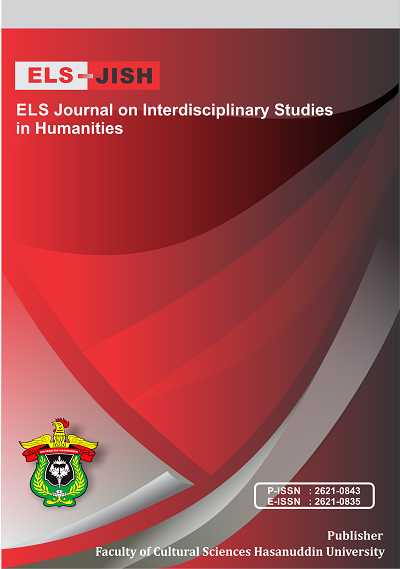Psychological Analysis of Landscape Linguistics in Public Spaces in Buru Island
DOI:
https://doi.org/10.34050/elsjish.v5i3.22549Keywords:
Buru, Linguistics, Landscape, Public AreaAbstract
Landscape Linguistics is a study that focuses on the use of language in public spaces, both monolingual, bilingual and multilingual. The purpose of this study is to analyze the linguistic psychology of landscapes in public spaces on Buru Island. The research method used is qualitative. In this study, researchers took sources from the nameplate or baleho found on Buru Island, precisely in Namlea Village. The data sources are several photos in public places on Buru Island. Analysis of research data, namely when researchers collect the results of information board documentation scattered on Buru Island, all of the documentation is classified according to their respective characteristics, namely, signboards, billboards and other information. Then the meaning and function are determined by using Landscape linguistic studies. The results of the study found that in the public space of the Buru Island community there were two variations of the language used, namely Indonesian and the Maluku dialect, as well as the Landscape function, namely Formal and Informal
References
Ben-Rafael, Eliezer, Elana Shohamy, Muhammad Hasan Amara, dan N. T.-H. (2006). Linguistic Landscape as Symbolic Construction of the Public Space: The Case of Israel. International Journal of Multilingualism, 3(1), 7–30.
Blommaert, Jan. (2013). Ethnography, Superdiversity and Linguistic Landscapes: Chronicles of Complexity. Ontario: Multilingual Matters.
Dagenais, D., Moore, D., Sabatier, C., Lamarre, P., & Armand, F. (2008). Linguistic landscape and language awareness. In Linguistic Landscape: Expanding the Scenery, (pp. 293-309). https://doi.org/10.4324/9780203930960
Cenoz, J., & Gorter, D. (2006). Linguistic landscape and minority languages. Linguistic Landscape: A New Approach to Multilingualism, 3(1), 67–80. https://doi.org/10.21832/9781853599170-005
Farran, B., Hortobágyi, I. (2020). the Linguistic Landscape of Ramallah , Palestine : a Case Study of Analysing the Dominance of English Vs . Arabic As L1 in the Main Street of the. SYNERGY, 16(2), 242–258.
Grzech, K., & Dohle, E. (2018). Language Landscape : An innovative tool for documenting and analysing linguistic landscapes. Lingue e Linguaggi, 25(0), 65–80. https://doi.org/10.1285/i22390359v25p65
Gorter, Durk. 2006. Further Possibilities for Linguistic Landscape Research. Clevedon: In Durk Gorter (Eds). Linguistic Landscape: A New Approach to Multilingualism. pp. 81-89. Clevedon: Multi Lingual Matters Ltd.
Gunawan Widiyanto. 2019. Lanskap Linguistik di Museum Radya Pustaka Surakarta. Prosiding Seminar Nasional Linguistik dan Sastra (SEMANTIKS). https://jurnal.uns.ac.id/prosidingsemantiks
Kostanski, L. (2009). What’s in a Name?’: Place and Toponymic Attachment, Identity and Dependence : A Case Study of The Grampians (Gariwerd) National Park name restoration process. University of Ballarat.
Landry, R., & Bourhis, R. Y. (1997). Linguistic landscape and ethnolinguistic vitality: An empirical study. Journal of Language and Social Psychology. 16(1), 23-49. https://doi.org/10.1177/0261927X970161002
Lou, J. J. (2016). Ethnography, superdiversity and linguistic landscapes: Chronicles of complexity. Bristol: Multilingual
Matters, 2013. Pp. xiv, 127. Pb. £17.95. Language in Society. https://doi.org/10.1017/s004740451600035x
Mulyawan, I. W. (2021). Maintaining and revitalising Balinese language in public space: A controversial language planning regulation. Indonesia and the Malay World, 49(145), 481–495. https://doi.org/10.1080/13639811.2021.1910356
Puzey, G. (2016). Linguistic Landscapes. In C. Hough (Ed.), The Oxford of Handbook of Names and Naming (pp.476–496). Oxford: Oxford University Press.
Sahril, Syahifuddin Zuhri Harahap, Agus Bambang Hermanto. 2019. Lanskap Linguistik Kota Meda: Kajian Onomastika, Semiotika, dan Sapasial. Medan Makna: Jurnal Ilmu Kebahasaan dan Kesastraan Vol 17, No 2 DOI: https://doi.org/10.26499/mm.v17i2.2141
Shohamy, E. & M. A. G.-M. (2012). Linguistic Landscape as a Tool for Interpreting Language Vitality: Arabic as a ‘Minority’ Language in Israel. In L. Van Gorter, D., Marten, H.F., and Mansel (Ed.), Minority Languages in the Linguistic Landscape (pp. 89–106). Palgrave Macmillan. https://doi.org/https://doi.org/10.1057/9780230360235_6.
Stroud, C., A., & Mpendukana., S. (2009). Towards a Material ethnography of Linguistic Landscape: Multilingualism, Mobility and Space in a South-African Township. Journal of Sociolinguistics, 13(3), 363–383.
Sugiyono. (2011). Metode Penelitian Kuantitatif, Kualitatif dan R&D. Alfabeta.
Widiyanto, G. (2019). Lanskap Linguistik di Museum Radya Pustaka Surakarta. Prosiding Seminar Nasional Linguistik Dan Sastra (Semantiks), Ll, 255–262. https://jurnal.uns.ac.id/prosidingsemantiks/article/view/39023/25974
Downloads
Published
How to Cite
Issue
Section
License
Copyright (c) 2022 Yulismayanti Yulismayanti, Risman Iye, Susiati Susiati, Harziko Harziko, Taufik Taufik, Fithriyah Inda Nur Abida

This work is licensed under a Creative Commons Attribution-NonCommercial-ShareAlike 4.0 International License.






